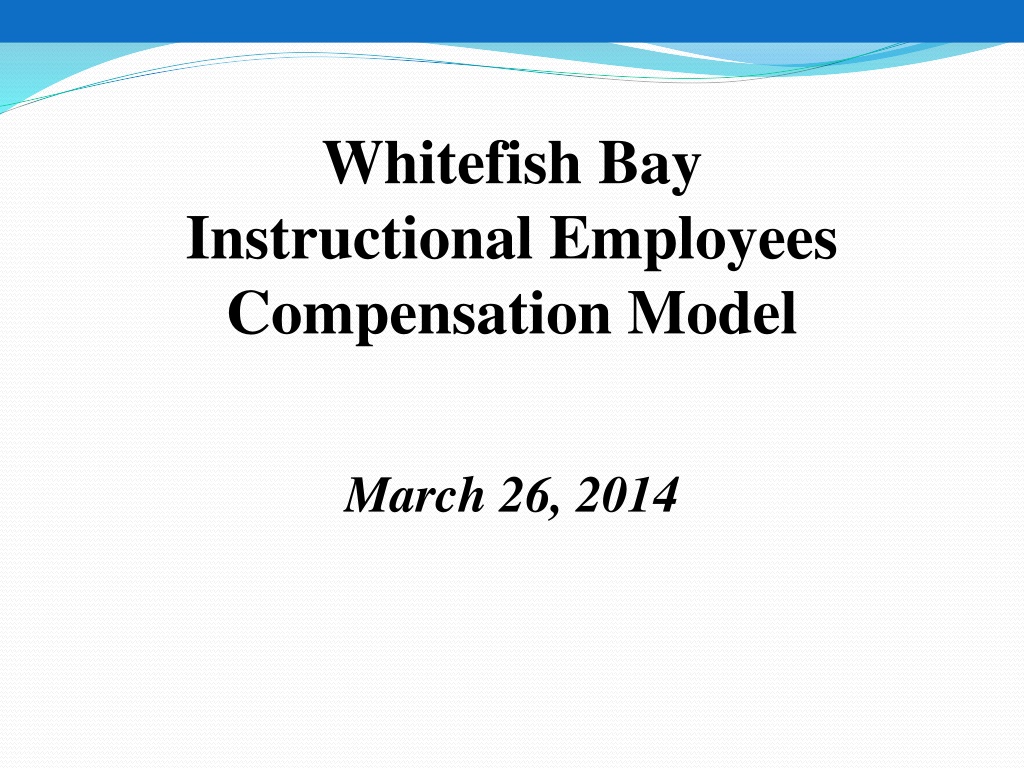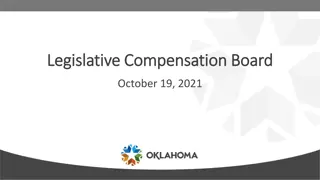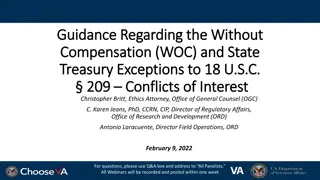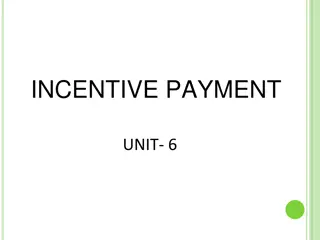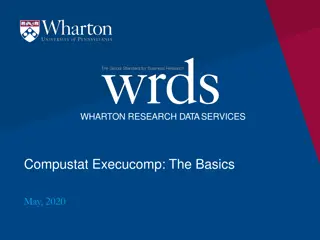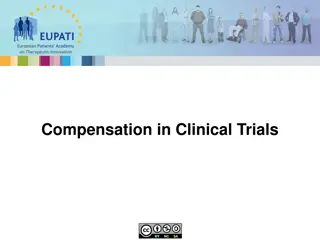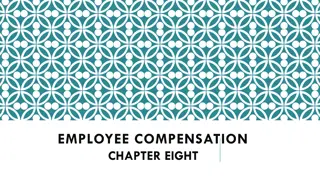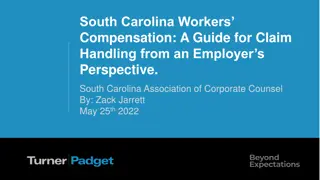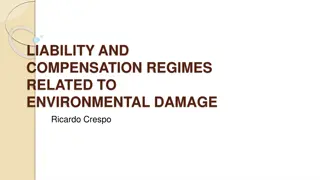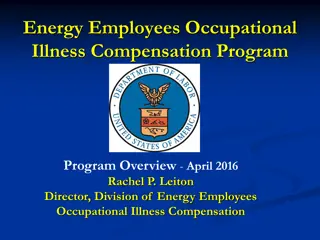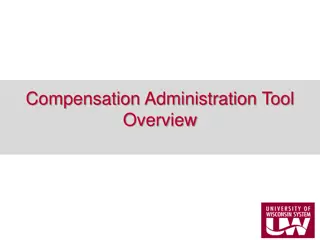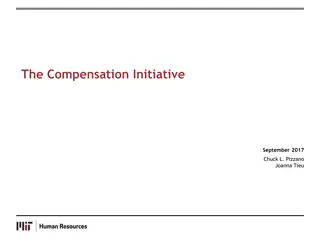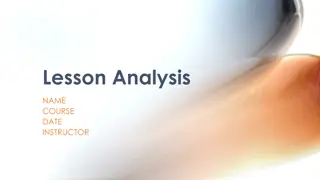Understanding Compensation Models for Instructional Employees
Exploring the Whitefish Bay Instructional Employees Compensation Model and its evolution, including changes in salary determination, state budget impacts, and prior compensation adjustments. Discussions on the significance of teacher compensation changes, elements of compensation beyond salary, and the design process of the new salary model are also covered.
Download Presentation

Please find below an Image/Link to download the presentation.
The content on the website is provided AS IS for your information and personal use only. It may not be sold, licensed, or shared on other websites without obtaining consent from the author. Download presentation by click this link. If you encounter any issues during the download, it is possible that the publisher has removed the file from their server.
E N D
Presentation Transcript
Whitefish Bay Instructional Employees Compensation Model March 26, 2014
Whitefish Bay Instructional Employees Compensation Model Three sections of this presentation: 1. Why does teacher compensation have to change? 2. What was involved in the design process of our salary model? 3. An explanation of the new salary model.
What is Compensation? Salary is an element of the compensation system. Other elements include: Health Insurance Dental Insurance Wisconsin Retirement Post-employment benefits Long-term disability Pay for add-on work (overloads, committees, mentoring, coaching, etc.) For most instructional employees, salary will account for 50-70% of total compensation package. Example: for a teacher with a salary of $50,000, the salary accounts for roughly 70% of the total compensation.
How was salary determined? Since 1970 s until 2011, salaries for instructional staff were formally bargained per state law. Under the former state law, increases to teacher compensation needed to reach the Qualified Economic Offer (QEO) which was set at 3.8%. The QEO did not include advancement on the educational lanes. So, aggregate teacher compensation often rose higher than 3.8% annually when lanes and steps were considered, as well as benefit cost increases.
State Budget Changes To help Wisconsin s significant budget deficit, fewer tax dollars have been allocated to public education. In 2008, Bay received $275 increase per resident student. In 2013, Bay received $75 increase per resident student. $743,000 vs $202,000 in new money is meant to account for price & salary increases for the district. Act 10 was implemented as the tools to reduce schools expenditures so they could better meet these revenue limits.
Prior Compensation Changes To help cope with budget retrains, changes have already occurred to employees compensation packages. Per state law, all district employees must now make an annual 50% contribution to their Wisconsin Retirement System. This constitutes about a $3,000-$7,000 out-of- pocket expense that used to be paid by the School Board/District. Other Post Employment Benefits (OPEB) have been reduced. Teachers hired after July 1, 2011 are not eligible for post employment health insurance. Rather, they are eligible for a tax shelter annuity ($1,000 per year) to access upon retirement (age 57 and 20 years of service).
Prior Compensation Changes Post employment health insurance for teachers hired before July 1, 2011 has been frozen at the 2011-12 district paid rates; insurance cost increases above that rate will be paid for by the retiree. Health insurance plans have been modified to increase the employee costs of deductible, co-insurance, and out-of- pocket co-pay costs for services and prescriptions. Since 2011, the teacher salary schedule was frozen; automatic raises for years of service and additional education were not granted. Rather, set dollar amounts were allocated for raises: $480 to teachers making more than $54,000/year and $1,000 to teachers making less than $54,000/year.
2011 Wisconsin Act 10 Collective Bargaining Changes (effective June 2011) Prohibits bargaining collectively with respect to any condition of employment except wages, which includes only total base wages and excludes any other compensation, such as overtime, premium pay, merit pay, performance pay, supplemental compensation, pay schedules, and automatic pay progressions. Limited to bargaining over a percentage of a total base wage increase no greater than the percentage change in the consumer price index (CPI). Gives school boards the power to design new teacher compensation systems outside of bargaining.
The Previous Uniform Salary Schedule Advantages: Pay increases were automatic. It was highly predictable for teachers. At the time, it was affordable.
Sample Uniform Salary Schedule Step 1 2 3 4 5 6 7 8 9 10 11 12 13 14 15 16 BA BA+6 40,335 40,865 41,527 42,610 43,694 44,778 45,860 46,945 48,028 49,219 BA+12 41,032 41,625 42,290 43,372 44,456 45,539 46,624 47,707 48,789 49,981 51,175 52,367 53,592 54,851 56,142 BA+18 41,858 42,389 43,051 44,134 45,220 46,302 47,385 48,468 49,552 50,744 51,935 53,127 54,352 55,613 56,903 BA+24 42,620 43,150 43,812 44,894 45,979 47,063 48,147 49,232 50,314 51,506 52,698 53,890 55,115 56,374 57,697 59,089 BA+30 43,382 44,042 44,774 45,855 46,940 48,023 49,107 50,191 51,274 52,465 53,658 54,983 56,342 57,732 59,188 60,777 MA 44,144 44,936 45,799 46,991 48,183 49,375 50,568 51,760 52,952 54,210 55,468 56,860 58,284 59,774 61,397 63,151 MA+6 44,936 45,799 46,726 47,917 49,110 50,305 51,496 52,689 53,879 55,138 56,528 58,052 59,608 61,232 62,987 64,907 MA+12 45,734 46,594 47,521 48,714 49,906 51,098 52,291 53,482 54,674 55,933 57,323 58,846 60,470 62,158 63,981 66,032 MA+18 46,661 47,521 48,449 49,641 50,833 52,024 53,228 54,409 55,600 56,860 58,251 59,774 61,431 63,152 65,008 67,093 MA+24 47,588 48,779 49,973 51,230 52,488 53,746 55,005 56,264 57,523 58,846 60,304 61,891 63,615 65,404 67,327 69,577 MA+30 48,514 50,040 51,494 52,818 54,146 55,466 56,799 58,119 59,438 60,838 62,357 64,016 65,804 67,653 69,646 72,050 39,573 40,103 40,765 41,847 42,932 44,017 Just a sample not Whitefish Bay s old schedule. Vertical steps represent pay for added year of service. Horizontal steps represent pay for additional education. Vertical and horizontal step movement is automatic the school district has committed itself to pay the salary increases inherent in step movement.
The Previous Uniform Salary Schedule Problems: Pay increases were automatic-- School boards and administration lacked control over continuing education yet paid increased salaries for it. Sustainability- State resources & ability to pay We used to have approximately $500,000 for compensation increases. New state budget allocations provide approximately $200,000, depending on the CPI, for compensation increases but the total new money into the district under the revenue cap might be $202,000.
The Salary Structure Design Process What do we want out of our compensation system? Attract and retain excellent teachers. Be fair & equitable- Minimize the current salary scale differentiation. ($36,000 - $77,000 range) Sustain the affordability of the model.
The Salary Structure Design Process The Charge from the School Board: Evaluate the needs and desires for our new compensation structure, review related research, and study comparable district s compensation offerings. Consider implications of the Compensation Committee s recommendations on the long-term financial health of the district. Present a comprehensive model for use by the district including considerations of attracting and retaining quality staff, honoring existing commitments to the extent possible, cost estimates, sustainability, and funding strategies.
The Salary Structure Design Process Form the Compensation Committee Two school board members, three administrative council members, & four teachers THANKS to the committee for their work! Educate and Study: Background education sessions held at each school. Analyze compensation from districts with whom we compete for employees. Our benefits are competitive Our beginning wage, in particular, is too low Study other compensation models, public and private sectors. Review related research studies.
The Salary Structure Design Process Survey Instructional Employees, Administration and School Board regarding salary, benefits, work conditions, and important factors to include in a salary structure. Some factors should raise the base salary Some factors should be one-time additional pay Raise the floor of the salary structure over time, without decreasing salaries.
The Salary Structure Design Process Develop fixes for those teachers earning less than $40,000 per year and those who would have earned lane movement on the old salary schedule. Institute one-time fixes prior to giving raises for the 2013- 14 school year. The 27 teachers earning less than $40,000 will jump to an base salary of $40,000. The 17 people who earned either a Masters or Doctorate will receive $2,000 added to their current salary. The 18 people who earned enough credits for a lane movement will receive $500 added to their current salary.
The Salary Structure Design Process Develop structures for funding sustainability Whether we have $100,000 or $500,000 to spend on raises, our salary model should not change. Without locking into specific dollar allocations, provide teachers an understandable view of their career path. Ongoing communications during the process with teachers, the administration, and the School Board. Bring the proposed model to the School Board for approval in spring before 2013-2014 retroactive raises are allocated. Although we can t finalize 2014 2015 salaries until after the state funds are allocated by October, we believe we can share an adequate estimate for salaries next school year.
The Proposed Model Eliminate the old salary schedule with set dollar amounts. Each teacher s current salary constitutes his/her base salary. No teacher s base salary will decrease. Teachers being non-renewed or on a Plan of Improvement will not receive a raise. Pay increases are based on most of the factors considered in the Compensation Study Survey.
The Proposed Model New teachers continue to be hired with a base salary determined by administration using the current criteria noted in the Instructional Employee Handbook: takes into consideration area of certification, years of experience, education and professional development, professional contributions to the school community and/or field of education, and specific job assignment.
The Proposed Model New pay structure for raises for all provides for: Pay range from $40,000 - $81,000. If currently below $40,000, the new base salary is $40,000. Except if on a Plan of Improvement or being non-renewed, everyone receives a raise unless your base wage is already $81,000. 2013-2014 funding available for raises matches CPI of 2.07%, plus additional funding from existing budget for the fixes ($40,000 base and recognition of lane movement). Raises are allocated on a sliding scale with more money being pushed to the lower-paid teachers and less money going to the higher-paid teachers. (About a 4:1 ratio)
The Proposed Model Factors for pay increases to be included, based on survey of teachers, administration, and school board: Some pay increase for everyone, unless already at the top of the scale Experience/Number of years in teaching and in district Performance as rated by supervisor (Incorporated through no raise if placed on a Plan of Improvement or being non- renewed.) Earning an advanced degree (Masters, Doctorate) Earning additional WI DPI certifications/licenses Earning National Board Certification (NBPTS.org) Teacher leadership roles (District committees, mentoring, coaching, department chairperson, etc.) Time slips for identified professional development hours
The Proposed Model Of the total budget available for raises, typically 85% used for raises for all teachers. More money to the lower paid teachers, less money to the higher paid teachers to build greater equity in the salary structure. No pay increase for employees place on a Plan of Improvement or being non-renewed. New salary range from $40,000 - $81,000.
The Proposed Model Of the total budget available for raises, typically 15% used for increases to teachers pay for Advanced Learning. Advanced Learning is: Typically worth National Board (NBPTS)Certification = $2,000 Preapproved Master Degree = $2,000 Ed Specialist/Doctorate Degree = $2,000 WI DPI certification/license = $300-$1,200 The pay increase is added to the base pay (not a one- time stipend)
The Proposed Model Non-reoccurring pay increases are still included in our pay structure. The budget allocation is above and beyond the typical CPI-generated funds for raises. Time slips for leadership roles Mentoring, district committee membership, curriculum writing, etc. Mentor training/certificate stipend. Additional pay for Department Chairpersons/Team Leaders. Additional pay for extra-curricular supervision. Overload assignments.
Examples 2014 Raise Raise for Add-on Pay for Base Base Fix for All Adv Lrng New Base Pay the year $36,977 $3,023 $0 $40,000 $120 $40,120 $39,963 $37 $1,590 $41,599 $324 $41,923 $47,708 $1,447 $2,000 $51,155 $51,155 $64,212 $500 $921 $65,633 $60 $65,693 $77,155 $512 $77,667 $3,480 $81,247 *Add-on, non-reoccurring pay might include mentoring, pay for committee work, coaching, etc.
Future Considerations Periodic review of internal and external comparables for equity. Annually, the School Board will determine if allocating more or less funding than each year s CPI is warranted. Any increase of more than CPI increase to the base gross wages would require a positive referendum vote. Refinement of the model for relevant factors for raises and the associated funding allocations.
Thank you for your time and attention.
